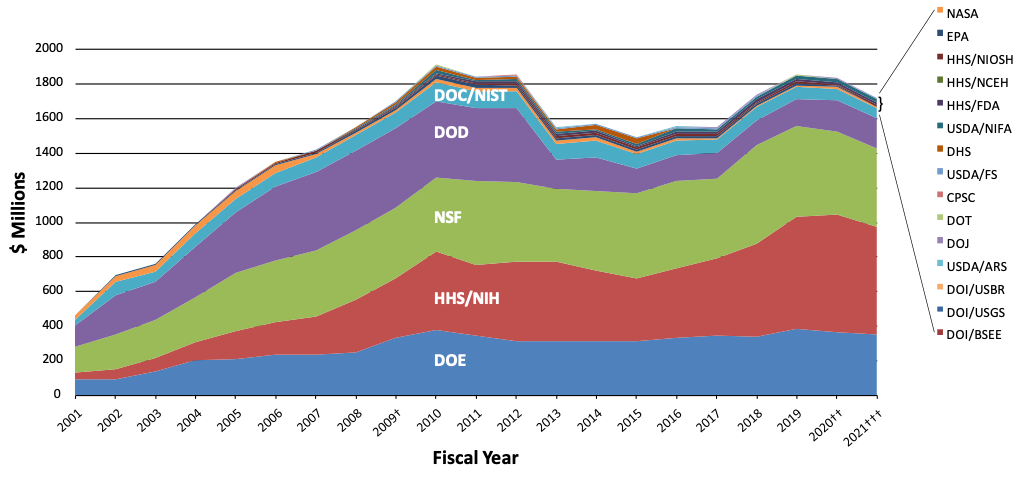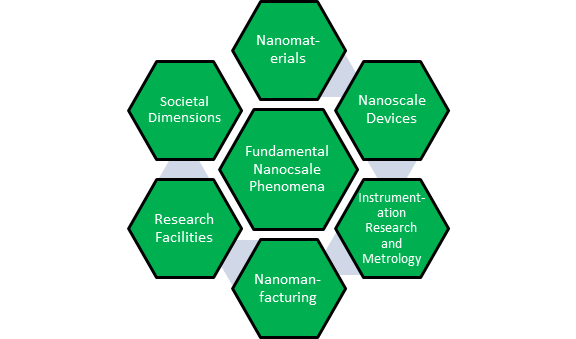If you’ve read our blog before, you probably remember that nanotechnology is the study and manipulation of matter at incredibly small sizes. It is used across all scientific fields, including chemistry, biology, physics, materials science and engineering, and it is at the forefront of some incredible discoveries and technological advances. In honor of Veterans Day in the U.S., I’d like to focus on some ways that this tiny science can fight several big barriers and be of great use in various military applications.

Nanotechnology research and development has a great role to play in materials and systems for military use (including national defense and homeland security). The U.S. Department of Defense (DoD) is a major research investor, spending a significant portion of the federal investment in nanotechnology, such as materials research, electronic devices research, or bio-chemical protection research.1 The overall Department of Defense investments in nanotechnology each year has gone up and down but remains high (hundreds of millions of dollars) since the National Nanotechnology Institute was founded in 2000:

In the mid-1990s the DoD identified nanotechnology as one of six “Strategic Research Areas.” The DoD nanotechnology program is grouped into seven program component areas, which mirror those of the U.S. National Nanotechnology Initiative (NNI)1:

So how do these nanotechnology research areas relate to Department of Defense interests? Military applications include a huge range areas including medicine, biological and chemical sensors, explosives, electronics for computing, power generation and storage, and structural materials for making vehicles, coatings, filters, and fabrics, and many of these applications have non-military uses as well.

Although most military research on nanotechnology should have a positive impact on our lives, there can also be some risks involved with these engineered nanomaterials, which can also negatively impact the environment. For example, military activities can result in explosions; blasts by high-tech weaponry can release toxic nanoparticles.1 Additionally, large-scale use of nanotech sensors could have an impact on the environment when these sensors start to degrade and engineered nanoparticles leak into the soil.1
Nanotechnology can help the military in many different ways. I have put a long list at the end of the post, but one example is in making super strong material for armor, with research exploring tungsten and carbon nanotubes for ballistic protection in personal body armor, bullet proof vests, and protective enclosures.4,5 Another application is “invisibility.” Scientists are researching ways to manipulate light so that soldiers seem to disappear. By use of “electrochromic camouflage,” fabric colors can change instantly to blend in with their surroundings.4 Here’s a video from ACS Reactions explaining how the “invisibility cloak” idea works:
When discussing military applications of science and technology (and other applications too), it is important to discuss the social, environmental, and ethical concerns that come up. All of these concerns can and should be analyzed using social, ethical, and legal perspectives. For example, there is an entire Center for Nanotechnology in Society that studies these issues, but for a quick summary I group the big concerns in two main categories:
Potential safety risks to consumers, workers and the environment
It is very important that consumers and workers are ensured proper protection and safety when nanotechnology is used in the military (as with any other context), and it should not have any adverse impact on them. While there are several positive environmental effects of nanotechnology, there are certain negative impacts as well which need to be addressed, such as increased toxicological pollution of the environment due to the uncertain shape, size, and chemical compositions of some of the nanotechnology products or nanomaterials. Synthesizing nanoparticles also requires a lot of energy. Finally, the release of toxic nano-substances can cause environmental harm, and we don’t have very good infrastructure yet for recovery and recycling of these materials.6
Potential human rights concerns
Human rights concerns related to nanotechnology include uneven access to the benefits of technology, unfair distribution of the profits associated with technology, negative social and anthropological impact of the technology, privacy and informed consent. Each of these topics are intrinsically interconnected. As discussed before, nanotechnology can pose potential risks to society which include environmental, health and safety issues. All of these can indirectly affect the economy as well in an adverse manner, especially in underdeveloped countries. There are also some transitional effects such as displacement of traditional industries as nanotechnology products become dominant. With the potential for new and improved surveillance devices, nanotechnology can also create privacy concerns.7
As with any new technology, it is important to consider the benefits and concerns that arise from nanotechnology research. Nanotechnology is definitely a boon with its many military applications, and research conducted for military purposes also can have great benefits in civilian contexts as well. See below for a list of some of the many areas of nanotechnology relevant to military (and civilian!) technology development.
You can also read our earlier posts related to military applications of nanotechnology and Veterans Day:
- A Veteran’s Story of One Summer with the Center for Sustainable Nanotechnology
- The CSN Research Experience for Veterans Program
- From Soldier to Scientist: The CSN’s Role in a Veteran’s Return to Civilian Life
- Nanoparticles – 5 Ways These “Little Fighters” Are Making a Big Impact in the War on Terrorism
Some more potential military applications of nanotechnology:4
- Increased surveillance for better protection
- Smaller cameras
- Cheap, small, and more effective weapons
- Exploration of the oceans
- Augmenting human performance
- Scratch resistant surfaces
- Stronger, thinner, and cheaper glass
- Coatings that don’t degrade (doesn’t need repainting)
- Lighter, faster aircraft which use less fuel
- Submarines and planes that can go undetected by radar
- Faster intensive medical help (“nano-medic”)
- The fabric in the nano-fibers in the uniform can constrict an injury into a tourniquet
- Sensors can provide the soldier’s vital signs and location to medics via radio
- Nano-size umbrellas
- They open to seal pores in cloth, making it impervious to airborne chemicals and pathogens
- Artificial muscles for enhanced strength
- All-electric Navy warship including nanotechnology components
- Next generation tiny fighter jets/surveillance drones including nano-size parts
- Fabrics embedded with nanowires and hydrogels to keep soldiers to warm in cold climates8
- ‘Second skin’ nanotube-based fabric that is highly breathable, reversible, and repels chemical and biological agents9
References
- Nano Werk. Military nanotechnology – how worried should we be? 2006. Retrieved from https://www.nanowerk.com/spotlight/spotid=1015.php
- National Nanotechnology Coordinating Office (NNCO). The National Nanotechnology Initiative—Supplement to the President’s 2021 Budget. 2020. Retrieved from https://www.nano.gov/sites/default/files/NNI-FY21-Budget-Supplement.pdf
- Kennedy et al. Fate and Toxicity of CuO Nanospheres and Nanorods used in Al/CuO Nanothermites Before and After Combustion. Environmental Science & Technology. 2013, 47(19), 11258-11267. doi: 10.1021/es401837f
- Institute for Chemical Education (ICE) and the University of Wisconsin-Madison Chemistry Department. Nanotechnology in the Military, National Defense Homeland Security. Retrieved from http://ice.chem.wisc.edu/Small%20Science/From_Small_Science_Comes_Big_Decisions/Choices_files/Military.pdf
- Bergius, W. Nanotubes make Kevlar armour smarter. 2017. Chemistry World. Retrieved from https://www.chemistryworld.com/news/nanotubes-make-kevlar-armour-smarter/3007057.article
- Zhang et al. Environmental Impacts of Nanotechnology and Its Products. Department of Mechanical Engineering, Wichita State University. 2011. Retrieved from https://faculty.atu.edu/cgreco/ASEEmw_2011/ASEE_2011_Proceedings/Peer_Reviewed_Papers/ASEE-MIDWEST_0030_c25dbf.pdf
- Nordberg, A. Nanotechnology, Human Rights, Patent law and the Global South: A Brief Overview. Lund University. 2013, Chapter 7 in New Technologies and Human Rights: Challenges to regulation. Routlage, ISBN 9780367601409. Retrieved from https://www.researchgate.net/publication/280735584_Nanotechnology_Human_Rights_Patent_law_and_the_Global_South_a_brief_overview
- Katwala, A. Nanotechnology could keep soldiers warm. Institution of Mechanical Engineers. 2017. Retrieved from http://www.imeche.org/news/news-article/nanotechnology-could-keep-soldiers-warm
- NanoWerk. Developing ‘second skin’ military nanotechnology fabric to repel chemical and biological agents. 2012. Retrieved from https://www.nanowerk.com/news2/newsid=27698.php

Very informative 👌
Sattikee
Thank you 🙂
Superb Shreyo! Very well written ❤️keep gifting us more 👌
Sattikee
Thank you so much 🙂